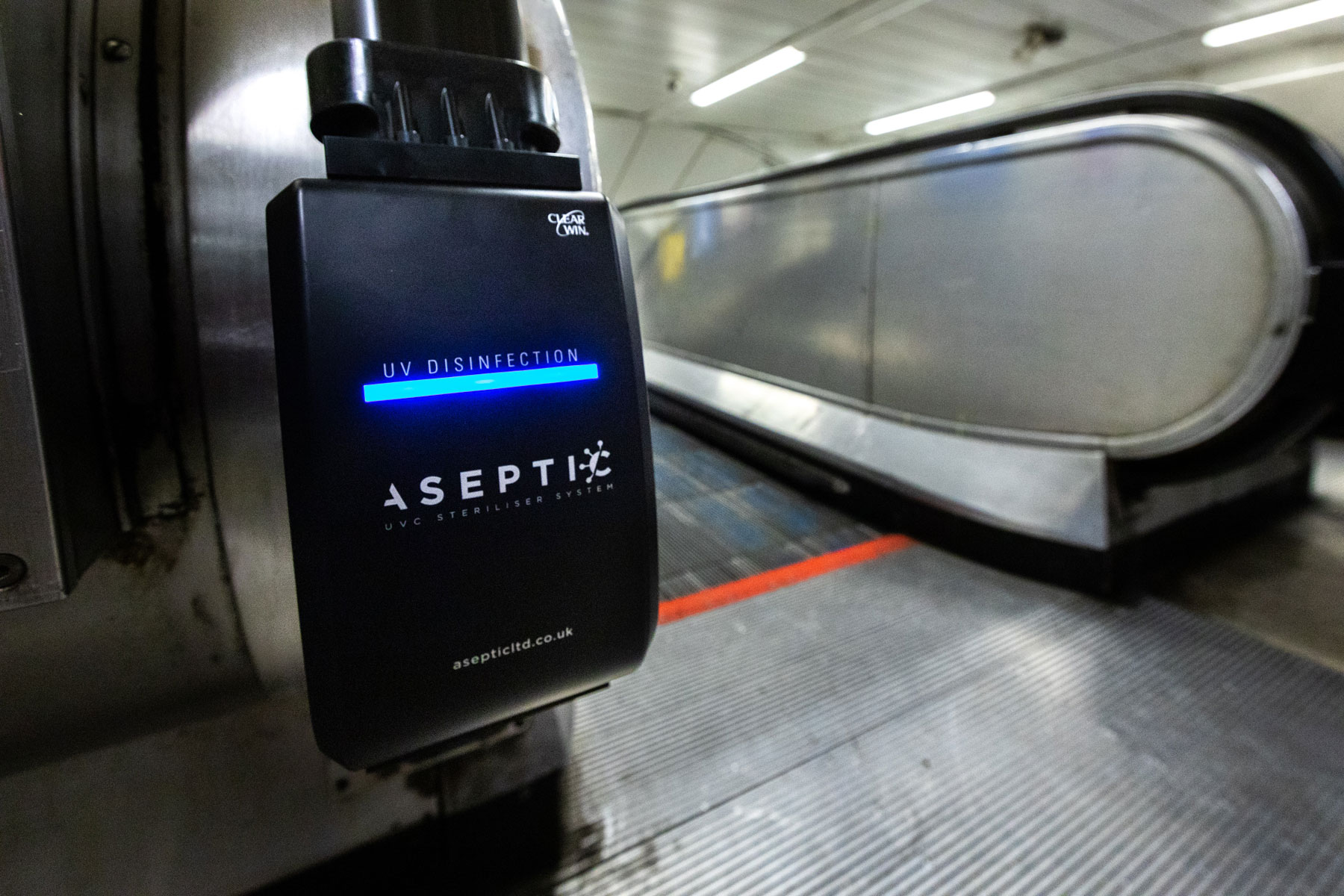Around a quarter of London Underground’s escalators are to be treated with ultraviolet (UV) light to help reduce Covid infections from spreading.
The UV light is being applied to the handrails in a continuous process throughout the day. People face a choice, to hold onto the handrail for personal safety as we’re told to, but also know that the handrail has been touched by hundreds of other people, and people are starting to be wary of holding the handrails.
By fitting a device at the end of the escalator over the handrail, every inch of the handrail gets a dose of UV light every few minutes, and TfL hopes that this will encourage people to start holding the handrail again.
Although UV light is a fairly proven way of killing viruses, and can deactivate (effectively kill) previous strains of coronavirus, it’s too soon to be sure if it has the same effect on Covid-19. However, the principle is sound, and the UV light still helps to improve the cleanliness of handrails.
To test the concept, trials were held earlier this year at Heathrow T123 Tube station, and as it was decided that the cleaning effect was a benefit in itself, they are now being rolled out across the London Underground.
The device, supplied by Aseptic clamps onto the outside of the escalator handrail, and then uses a classic dynamo similar to those fitted to bicycle lamps to generate electricity and light up the UV lamp inside. The idea of using a dynamo to power the UV lamp makes it much easier to fit the devices as there’s no need to find a local power supply, along with the safety permits needed to wire up the device.
Devices have already been fitted on six escalators at King’s Cross St Pancras Tube station, and over 200 of the sanitising devices will be installed on 110 escalators in the coming weeks, meaning almost a quarter of all escalators on the network will be fitted with the devices.
TfL is focusing on the busiest stations, including Bond Street, Charing Cross, Green Park, London Bridge, Paddington, Tottenham Court Road, Victoria and Waterloo.
TfL has regularly tested for coronavirus on the transport network with no evidence of the virus found to date and, last month, a new testing plan with Imperial College London started. The results from the first round of collaborative sampling in September have already been received and were, again, all negative for the presence of COVID-19.









I think that’s a great idea. Perhaps installing them on escalators at shopping centres, airports, supermarkets, office buildings and other buildings. That is a great idea.
“TfL has regularly tested for coronavirus on the transport network with no evidence of the virus found to date.”
To the extent that this is true, procuring and fitting these devices is a waste of money, time and effort.
“the UV light still helps to improve the cleanliness of handrails.” <-- worth add them. "and TfL hopes that this will encourage people to start holding the handrail again." <-- worth adding them.
I don’t thinks it does any harm to install these – infact the reverse: it increases user confidence (even if the actual risk is negligible) and also safety. And I suspect the chance of catching / spreading coronavirus is very low but not zero. And if the chance of spreading underground were to rise better to be prepared than fight rearguard action.
“Absence of evidence is not evidence of absence” – traditional aphorism
I can see these becoming a permanent feature and as Andrew said, fitting to escalators in shopping centres etc would be good.
Don’t forget it is not just Covid but other common viruses such as flu & Noro that we are up against.
They may not end up killing millions of bugs but may help reassure people.
I was told that handrails on stairs and doors used to be made of Copper based alloys such as Brass or Bronze as this had the ability to kill bacteria. The move to making things that people touch out of stainless steel or plastic seems to be a retrograde move.
I am not clear if copper kills viruses – can anyone confirm either way with reference to an appropriate refereed publication.
You can’t make an escalator handrail out of brass or bronze!
Marvelous idea 👍 Roll this out worldwide! 😁
Useful addition as plenty of other germs are transmitted by surface contact. But I do wonder about the effect of UV on the “rubber” handrails.
And finally, I assume that in a nod to LU tradition, each sanitiser is unique to its escalator and will need a complete refurbishment with bespoke parts every so often?
To install uvc for sanitization of handrails makes sense. But those devices create on the upper and lower end of it a gap to the handrail. I hope children stay away from those interesting looking devices not to get trapped with there small fingers.
Is there a reason why you think they left finger-sized gaps between the device and the moving handrail?
I have seen those devices. There is a gap, they do not fulfill (BS)EN115-1.